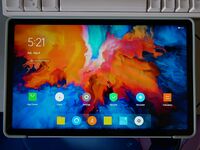Lenovo Tab P11 (lenovo-j606f)
| This device is marked as not booting. Status: Mainline DTS available; No device package yet |
 Lenovo Tab P11 | |
| Manufacturer | Lenovo |
|---|---|
| Name | Tab P11 |
| Codename | lenovo-tbj606f |
| Released | 2020 |
| Hardware | |
| Chipset | Qualcomm Snapdragon 662 (SM6115) |
| CPU |
Octa-core (4x2.0 GHz Kryo 260 Gold 4x1.8 GHz Kryo 260 Silver) |
| GPU | Adreno 610 |
| Display | 1200 x 2000 |
| Storage | 64/128 GB |
| Memory | 4/6 GB |
| Architecture | aarch64 |
| Software | |
Original software The software and version the device was shipped with. |
Android 10 |
Extended version The most recent supported version from the manufacturer. |
Android 11 |
Mainline Instead of a Linux kernel fork, it is possible to run (Close to) Mainline. |
no |
Contributors
- MollySophia
Users owning this device
- NBon (Notes: Untested yet)
- Ungeskriptet (Notes: Broken LCD)
How to enter flash mode
- Bootloader Mode: Power on the device by holding down and
- Recovery Mode: Power on the device by holding down , and
- EDL Mode: Hold down while connecting the tablet to a computer with a USB-C cable
Unlocking the bootloader
| WARNING: Unlocking the bootloader will wipe all user data on the device |
| Note: This process may vary depending on the region where you have bought the tablet |
- Enable developer options and turn on OEM unlocking in the Android settings
- Reboot into the bootloader by holding down and
- Connect the tablet to a computer with a USB-C cable and run the following command:
$ fastboot flashing unlock
- Confirm unlocking the bootloader by selecting "UNLOCK THE BOOTLOADER" on the tablet using the volume and power keys
Back to stock firmware
| WARNING: Restoring the firmware will wipe all user data on the device |
- Install the qdl tool from here. Arch Linux users can simply install the qdl-git AUR package.
- Download the firmware that suits your model from here. The latest global firmware version as of November 2024 is
TB-J606F_S320383_240603_ROW - Extract the ZIP archive and open a terminal inside the directory
- Reboot the device into EDL mode by holding down while connecting the tablet to a computer with a USB-C cable
- Run the following command:
$ qdl --storage ufs --include ./ ./prog_firehose_ddr.elf ./rawprogram_unsparse0.xml ./patch0.xml ./rawprogram1.xml ./patch1.xml ./rawprogram2.xml ./patch2.xml ./rawprogram3.xml ./patch3.xml ./rawprogram4.xml ./patch4.xml ./rawprogram5.xml ./patch5.xml
- If you have trouble running the command above, make sure your udev rules are set up correctly. Alternatively, you can try running the command with sudo
- After the tablet reboots, Android should be running again
Notes
This device uses Qualcomm SM6115 chipset, which is almost the same as the SM4250 chipset OnePlus Nord N100 is using. Using stock kernel source from Lenovo website and the installation procedure OnePlus Nord N100 device page suggests, I got similar results with OnePlus Nord N100: USB Network and the vibrator are working, which indicates again that these two devices are fairly similar.
The vendor poorly released it's kernel. The kernel source code is older than the latest stock firmware (Android 10 : 0906, Android 11 has much later dated android builds and bootloader), and the kernel does not contain drivers for peripherals contained in later-built P11s, such as the touch screen driver for variants using the NovaTek touch panel. The kernel for android 11 is fully unreleased, although it is unknown if Android 10's kernel also works with the bootloader of Android 11. (Not even sure if it can be reverted.) If possible, it might be easier to go to the mainline route, than requesting the code to Lenovo. (Lenovo refused to provide the code.)
Installation
/* Not yet */